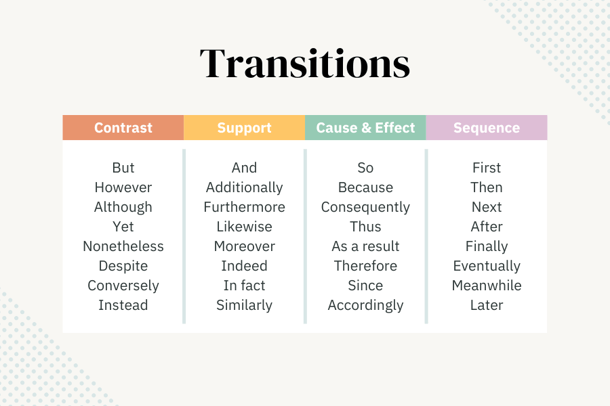The SAT Reading & Writing section and ACT English section do an excellent job of rewarding those students who read carefully and penalizing those who do not. Perhaps nowhere is this more evident than in the "Transition" question type, where a student must choose the best word to transition within or between sentences. To master Transition questions, it's critical that you read at least the whole sentence, identify the relationship that your transition word must convey, and select the most succinct answer choice that connects the ideas accordingly. Follow the steps below to ace these questions in the future.
Step 1: Read the whole sentence.
Some students like to take shortcuts on the grammar sections of the SAT and ACT. Indeed, it can be tempting to skip straight to the answer choices and start plugging them in one by one. However, Transition questions are almost impossible to answer correctly if you don’t read at least the whole sentence or pair of sentences joined by the transition. Here’s an example:

If we look only at the second sentence, we simply won’t have enough information to decide which word should go in the blank. In fact, any one of the answer choices could conceivably work. We need to widen our field of vision and read the prior sentence to understand the relationship between the first and second sentences.
Step 2: Identify the relationship.
After you read all of the necessary context, decide which type of connector word you need to fit in the blank. In general, there are four main types of relationships your word should convey: contrast, support, cause & effect, and time.
Contrast: A contrast word demonstrates that two ideas disagree or go against one-another.
- Example: I went to the store, but I didn’t buy anything.
Support: Support words show that two ideas are connected and reinforce one-another.
- Example: She is my best friend, and I’d do anything for her!
Cause & Effect: Cause-and-effect words signal that one thing causes another to occur.
- Example: He didn’t pay the meter, so he received a ticket.
Sequence: Sequential words indicate the order or time at which one thing occurs in relation to another.
- Example: After three hours of waiting in the lobby, we were finally admitted into the office.
Here are a few more examples for your reference:

Let’s look at our sample question one more time:

In this question, we know that Josephine’s volunteer activity will help her satisfy her volunteerism requirement. In other words, it will cause her to fulfill the requisite hours. We need a cause-and-effect word.
Step 3: Be concise.
Occasionally, you’ll find that two or more answer choices fall under the same transition category. In the above example, two answer choices seem to indicate a cause-and-effect relationship: answers B and C. However, answer C is nice and concise, whereas answer B uses excess verbiage. In these cases, always go concise. Nine times out of ten, the shorter transition word will be the correct transition word.
Transition questions are easy to master if you follow these three easy steps: read all necessary context, think about relationships, and eliminate excess verbiage.
For more tips, download our guide to the 6 skills you need to master for the SAT and the 6 skills you need to master for the ACT.
Need more individualized advice?
The recommendations above are general suggestions. If you have specific questions about your individual test prep plans, reach out to our experts here. We’re happy to help in any way we can.
Related Posts
How To Properly Connect Clauses on the ACT & SAT
How To Answer "Words in Context" Questions on the SAT Reading & Writing Section
About ArborBridge
ArborBridge is the global leader in innovative, digital, one-on-one tutoring. With nearly a decade of experience teaching students online, ArborBridge supports students of all kinds: home schoolers, AP students, test preppers, and more. Our tutors specialize in creating personalized plans and in providing compassionate support for students and families.







